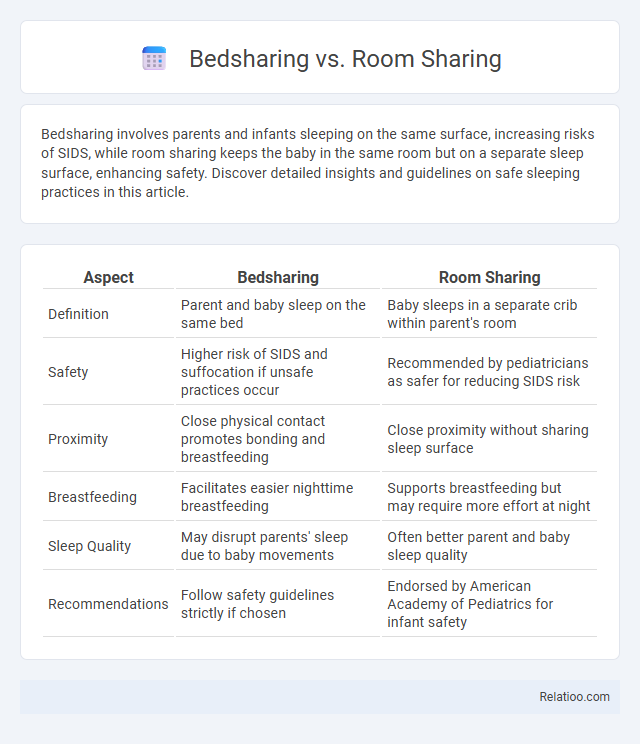Bedsharing involves parents and infants sleeping on the same surface, increasing risks of SIDS, while room sharing keeps the baby in the same room but on a separate sleep surface, enhancing safety. Discover detailed insights and guidelines on safe sleeping practices in this article.
Table of Comparison
| Aspect | Bedsharing | Room Sharing |
|---|---|---|
| Definition | Parent and baby sleep on the same bed | Baby sleeps in a separate crib within parent's room |
| Safety | Higher risk of SIDS and suffocation if unsafe practices occur | Recommended by pediatricians as safer for reducing SIDS risk |
| Proximity | Close physical contact promotes bonding and breastfeeding | Close proximity without sharing sleep surface |
| Breastfeeding | Facilitates easier nighttime breastfeeding | Supports breastfeeding but may require more effort at night |
| Sleep Quality | May disrupt parents' sleep due to baby movements | Often better parent and baby sleep quality |
| Recommendations | Follow safety guidelines strictly if chosen | Endorsed by American Academy of Pediatrics for infant safety |
Understanding Bedsharing and Room Sharing
Bedsharing involves your infant sleeping in the same bed as you, which may increase the risk of SIDS and accidental suffocation, while room sharing means your baby sleeps in a separate crib or bassinet within your bedroom, offering safer monitoring without direct bed contact. Sleep hygiene practices for infants emphasize creating a consistent, quiet, and comfortable sleep environment, crucial for establishing healthy sleep patterns whether bedsharing or room sharing. Understanding these distinctions helps you make informed choices that prioritize your baby's safety and sleep quality.
Key Differences Between Bedsharing and Room Sharing
Bedsharing involves parents and infants sleeping on the same surface, raising concerns about safety risks such as suffocation and Sudden Infant Death Syndrome (SIDS), while room sharing means the infant sleeps in the same room but on a separate sleep surface like a crib. Room sharing is recommended by pediatricians because it allows close proximity for feeding and monitoring without the hazards associated with bedsharing. Sleep hygiene practices for infants emphasize consistent sleep environments, safe sleep surfaces, and routines that reduce risks and promote healthy sleep patterns.
Benefits of Bedsharing for Infants and Parents
Bedsharing promotes breastfeeding by allowing easier nighttime feeding and fostering stronger parent-infant bonding through close physical contact. Infants experience improved temperature regulation and reduced stress levels, while parents benefit from increased sleep efficiency and responsiveness to their baby's needs. This practice supports emotional security and can enhance overall family well-being when implemented with proper safety guidelines.
Benefits of Room Sharing Without Bedsharing
Room sharing without bedsharing significantly reduces the risk of Sudden Infant Death Syndrome (SIDS) by allowing parents to closely monitor their baby while maintaining a separate sleep surface. This arrangement supports better sleep hygiene for both infant and parents, promoting safer sleep environments and reducing disturbances. It enables easier nighttime feeding and comforting, enhancing infant security and parental responsiveness without the hazards associated with bedsharing.
Safety Guidelines for Bedsharing
Bedsharing safety guidelines emphasize placing infants on a firm mattress without pillows, blankets, or soft bedding to reduce the risk of suffocation and Sudden Infant Death Syndrome (SIDS). Room sharing, where the baby sleeps in the same room but on a separate surface, is recommended by the American Academy of Pediatrics as a safer alternative to bedsharing. Maintaining good sleep hygiene involves consistent sleep routines and safe sleep environments that prioritize infant safety and minimize hazards like overheating and accidental suffocation.
How Room Sharing Supports Safer Sleep
Room sharing supports safer sleep by keeping Your infant close without sharing the same sleeping surface, reducing the risk of sudden infant death syndrome (SIDS). The American Academy of Pediatrics recommends room sharing for at least the first six months, allowing parent supervision and easier response to the baby's needs. Maintaining a separate crib or bassinet within your bedroom fosters better sleep hygiene by providing a safe, separate space for the baby while ensuring proximity for monitoring.
Common Misconceptions About Bedsharing
Many parents believe bedsharing inherently increases the risk of SIDS, but safe bedsharing practices can mitigate dangers when combined with proper sleep hygiene. Room sharing without bedsharing allows caregivers to monitor infants closely while minimizing exposure to hazards like loose bedding or falls. Prioritizing a firm mattress, avoiding soft bedding, and ensuring smoke-free environments are key components of healthy sleep hygiene that support infant safety regardless of sleeping arrangement.
Expert Recommendations on Infant Sleep Arrangements
Expert recommendations on infant sleep arrangements emphasize room sharing without bedsharing to reduce the risk of Sudden Infant Death Syndrome (SIDS). The American Academy of Pediatrics (AAP) advises that infants sleep on a separate, firm surface within the parents' room for at least the first six months. Proper sleep hygiene, including consistent bedtime routines and a smoke-free environment, further supports safe infant sleep and optimal developmental outcomes.
Factors to Consider When Choosing Sleep Arrangements
When choosing between bedsharing and room sharing, consider your baby's age, safety guidelines, and the risk of Sudden Infant Death Syndrome (SIDS). Sleep hygiene plays a crucial role; maintaining a consistent bedtime routine and a smoke-free environment enhances your baby's sleep quality regardless of the arrangement. Your comfort level and ability to monitor your infant effectively are key factors in selecting the safest and most restful sleep setting.
Making an Informed Decision: Bedsharing vs Room Sharing
Choosing between bedsharing and room sharing involves balancing safety, comfort, and developmental needs, as room sharing without bedsharing is recommended by pediatric experts to reduce the risk of sudden infant death syndrome (SIDS). Studies indicate that room sharing maintains proximity for breastfeeding and monitoring while minimizing hazards such as suffocation or overheating linked to bedsharing. Prioritizing sleep hygiene, parents should ensure a firm mattress, avoid soft bedding, and follow safe sleep guidelines to create a secure sleep environment regardless of the chosen arrangement.

Infographic: Bedsharing vs Room Sharing
 relatioo.com
relatioo.com